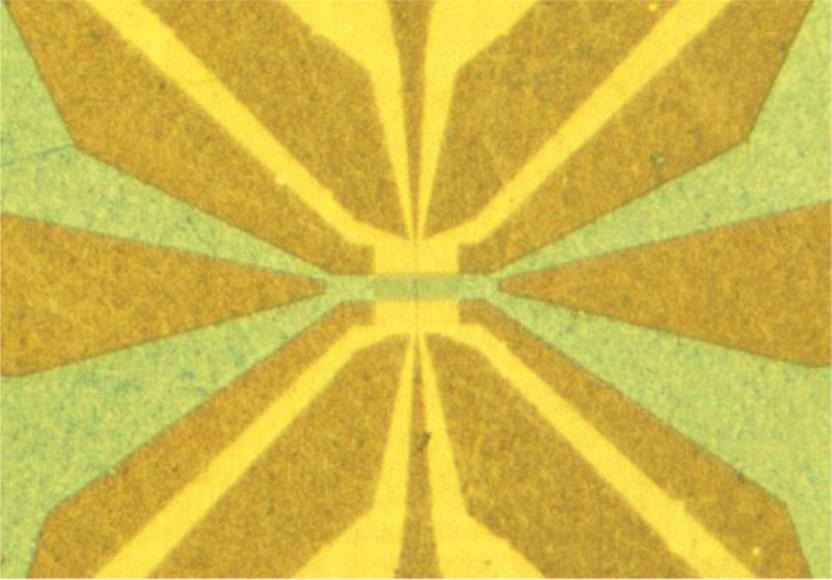Superconducting coupling between two regions divided by a wide ferromagnetic compound measuring one micron has been established by a team of international researchers.
 Device where the long-range Josephson coupling has been demonstrated. Superconducting YBa2Cu3O7 regions (yellow) are separated by a half-metal La2/3Sr1/3MnO3 ferromagnet (green). (Image Credit: © Nature Materials 2021: 10.1038/s41563-021-01162-5).
Device where the long-range Josephson coupling has been demonstrated. Superconducting YBa2Cu3O7 regions (yellow) are separated by a half-metal La2/3Sr1/3MnO3 ferromagnet (green). (Image Credit: © Nature Materials 2021: 10.1038/s41563-021-01162-5).
This macroscopic quantum effect, called the Josephson effect, produces an electrical current inside the ferromagnetic compound composed of superconducting Cooper-pairs. Magnetic imaging of the ferromagnetic region at BESSY II has helped to show that the spin of the electrons creating the Cooper pairs is equal.
These findings open the door for low energy consumption superconducting spintronic-applications where spin-polarized currents can be guarded by quantum coherence.
When two superconducting regions are divided by a piece of non-superconducting material, an unusual quantum effect can take place, coupling both regions: The Josephson effect. If the spacer material is a half-metal ferromagnet, new implications for spintronic applications crop up.
Recently, an international team of researchers has for the first time engineered a material system that displays a remarkably long-range Josephson effect: Here, regions of superconducting YBa2Cu3O7 are divided by a region of half-metallic, ferromagnetic manganite (La2/3Sr1/3MnO3) measuring one micron wide.
Using magneto-transport measurements, the team was able to show the existence of a supercurrent flowing through the manganite – this supercurrent is cropping up from the superconducting coupling between both superconducting regions, and therefore a manifestation of a Josephson effect possessing a macroscopic long range.
Extremely Rare: Triplett Superconductivity
Furthermore, the researchers investigated another stimulating property with weighty consequences for spintronic applications. In superconductors, electrons tend to pair together and are referred to as Cooper pairs.
In most superconducting materials, these pairs are made up of electrons with opposite spin in order to decrease the magnetic exchange field which is harmful for the stabilization of superconductivity. The ferromagnet used by the international scientists has been a half-ferromagnet for which just one spin-type electron is permitted to flow.
The fact that a supercurrent has been identified inside this material, suggests that the Cooper pairs of this supercurrent have to be made up of electrons possessing the same spin. This so-called “triplet” superconductivity is very uncommon.
Mapping Magnetic Domains at BESSY II
At the XMCD-PEEM station at BESSY II, we mapped and measured the magnetic domains within the manganite spacer. We observed wide regions homogeneously magnetised and connecting the superconducting regions. Triplet spin pairs can propagate freely in these.
Dr. Sergio Valencia Molina, Physicist, HZB
Dr. Sergio Valencia Molina oversaw the measurements at BESSY II.
Superconducting currents pass without resistance which renders them very attractive for low-energy consumption applications. In the present scenario, this current is composed of electrons with equal spins. Such spin-polarized currents can be employed in unique superconducting spintronic applications for the circulation (across great distances) and reading/writing of data while benefiting from the stability enforced by the macroscopic quantum coherence of the Josephson effect.
The new device composed of the ferromagnetic and superconducting components thus paves the way for opportunities for superconducting spintronics and new perceptions for quantum computing.
Cooperations
The department of Spin and Topology in Quantum Materials at HZB has contributed to this international collaboration (Spain, France, Russia, United States and Germany) led by Prof. Jacobo Santamaria from the Complutense University of Madrid (Spain) and Javier Villegas from the 2Unité Mixte de Physique CNRS/THALES (France).
Funding: To2Dox, ERA-NET, EU Horizon 2020
Journal Reference:
Sanchez-Manzano, D., et al. (2021) Extremely long-range, high-temperature Josephson coupling across a half-metallic ferromagnet. Nature Materials. doi.org/10.1038/s41563-021-01162-5.